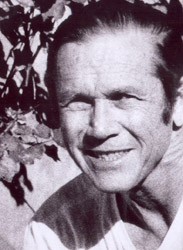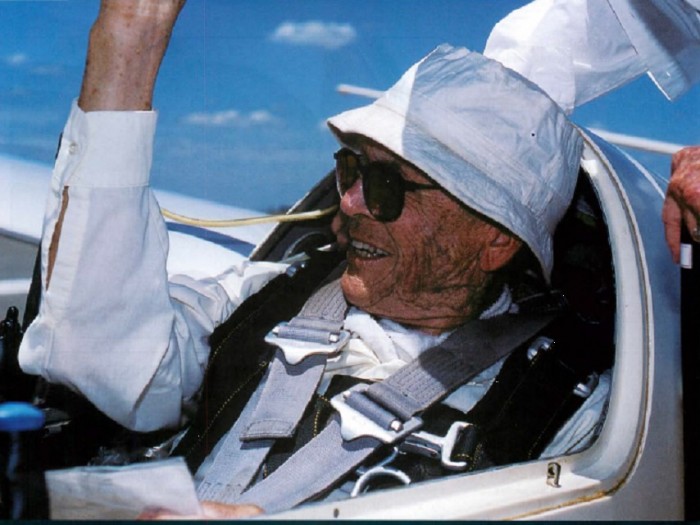Richard II Johnson
1956
about
(1923-2008) SSA Director; World/National Competition; World/National Records; Sailplane Performance Studies/Tests; WW II Glider Instructor
Awards
Lilienthal Medal; Tissandier Diploma; OSTIV Plaque/Klemperer Award 1983; Eaton Trophy 1967; Tuntland Award 6 yrs; Exceptional Service Award; Barnaby Lecture; du Pont Trophy 10 yrs; Standard, Stroukoff Trophies; Silver 1940; Gold 1947; Dia #33 1964; 1 Lennie
Bio

Dick Johnson was the quintessential soaring pilot. He exhibited genuine enthusiasm for helping us understand the science of soaring. He encouraged all pilots to aspire to the same success he achieved in his lifetime by describing the most subtle aspects of soaring flight and helping us discover the secrets of aerodynamic efficiency. What is most important, he set an example of how a life could be lived. He himself extracted all the energy he could out of every day of his life.
Dick Johnson was born January 10, 1923 in Alberta, Canada, and grew up in the Los Altos area of Northern California. Like so many youngsters of his time, he built model airplanes and gliders. In 1938 he read Wolf Hirth's book, The Art of Soaring Flight and bought a second hand Northrop Primary glider with which he taught himself to fly with the help of his brother Dave. In 1939 at age 16 and still in high school, he bought a Bowlus Baby Albatross kit which he assembled in his spare time. He and his brother Dave built a wooden trailer and towed the glider and trailer the 3,000 miles from California to Elmira, New York for the 1940 U.S. National Gliding Championships. Upon his arrival he needed both a pilot license and certification for his glider. He obtained these, earned Silver Badge #28 and placed third in the contest. Thus began a very successful life of competition.
After graduating from high school, he returned again to Elmira in 1941 for another Nationals, sold the Baby Albatross, bought a Schweizer SGS-8 two-place, earned his Commercial Glider license, qualified for his Gold Badge, and placed fourth in the contest. World War II started and his SGS-8 was confiscated for use by the military. Dick became a Civilian Glider Flight Instructor at Twentynine Palms Air Academy in Southern California and continued his personal soaring with another Bowlus Baby Albatross.
When the last military class graduated, Dick joined Pan American World Airways as a co-pilot. He resigned in 1948 deciding to pursue his career in aeronautical engineering. He also completed the partially constructed Tiny Mite he had purchased from Ray Parker. He decided he needed something better than the short wing Tiny Mite so worked with Harland Ross to construct the 16.77 meter RJ-5 sailplane with a laminar airfoil. He continued his studies at Mississippi State and became a part-time assistant to Dr. August Raspet in the AeroPhysics Research Laboratory where he worked as a pilot on research projects and sailplane performance studies. In 1950 he took the RJ-5 to Grand Prairie, Texas where he won the first of 11 U.S. National Soaring Contests. After making some improvements to the RJ-5 he set a World Distance Record of 535 miles (861 km) becoming the first pilot in the world to soar more than 500 miles and setting a record that stood for 12 years.
He continued studying (MS from Stanford in 1953), setting world records and winning national competitions. In 1980 he took his barely completed Adastra two-place to Cologne for the World Championships. Next he assisted Len Niemi flight testing the prototype Sisu-1 metal sailplane and flew the first production model in the 1963 World championships in Argentina, placing fourth in the Open Class. He continued winning Nationals and entering world contests for many more years - see the Soaring articles for contest information.

In 1975 he began the "Sailplane Flight Test Evaluation" series for Soaring magazine which became extremely popular and continued until 2008. There is much more to tell you but we need to save space for his awards = FAI Lilienthal Medal (1986), Tissandier Diploma (1976), OSTIV/Klemperer Award (1983), SSA Eaton Trophy (1967), Tuntland Award (1977, 1979, 1983, 1995, 2000, 2007), Exceptional Service Award (1982) and he gave the Barnaby Lecture in 1995. For competition, he received the du Pont Trophy (1950, 1951, 1952, 1954, 1959, 1963, 1964, 1975, 1981, 1985), Standard Class Trophy (1974), Stroukoff Trophy (1975, 1981, 1985). He was awarded Silver #28 (1940), Gold #21 (1947), Diamond #33 (Int #370, 1964), Symons One Lennie #53.
There will never be another one quite like Dick Johnson - both as a pilot and as a man.
Note - While having lunch with Dick Johnson one afternoon in Minden, this reporter tried to explain why she did not fly in contests - "I just fly for fun." His immediate response - "So do I!"
(adapted from Soaring, October 2008, page 19)